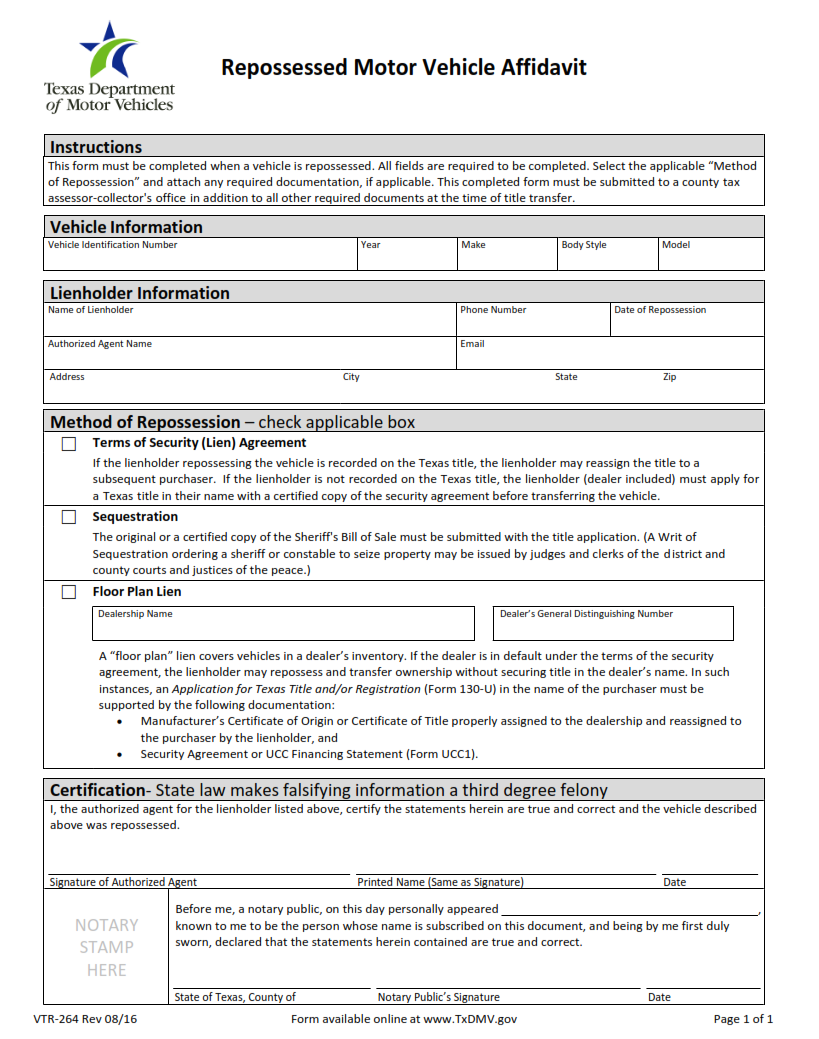ORIGINFORMSTUDIO.COM – VTR-264 – Repossessed Motor Vehicle Affidavit – This article will discuss the VTR-264 – Repossessed Motor Vehicle Affidavit, a document used by lenders to repossess motor vehicles. This affidavit is necessary for Texas residents who are unable to make payments on their vehicle loan and need to surrender it back to the lender. The document serves as proof of ownership and gives the lender permission to repossess the vehicle. It also provides information about how long the process takes, when payment is due, and what happens if you cannot make timely payments.
Download VTR-264 – Repossessed Motor Vehicle Affidavit
| Form Number | VTR-264 |
| Form Title | Repossessed Motor Vehicle Affidavit |
| File Size | 1 MB |
| Form By | Texas DMV Form |
What is a VTR-264 Form?
A VTR-264 form is a Repossessed Motor Vehicle Affidavit that is issued by the Texas Department of Motor Vehicles (TxDMV). This form is used to document the details of a repossessed motor vehicle, including the date and time of repossession, name and address of lien holder, make and model of vehicle, license plate number, year manufactured, and any other relevant information. The completed affidavit must be filed with TxDMV within 10 days after the vehicle has been repossessed.
In addition to providing information about the repossessed motor vehicle, this affidavit also requires signatures from both the lien holder and borrower. Once signed by both parties, it will be sent either to another state or back to TxDMV for official processing.
What is the Purpose of the VTR-264 Form?
The VTR-264 form is an affidavit that must be completed by a person or business when repossessing a motor vehicle. The information provided in the form serves two primary purposes.
Firstly, it is used as evidence to prove ownership of the vehicle. This includes details such as the name and contact information of the lien holder, and any subsequent transfers of title or interest in the vehicle. The VTR-264 also provides proof that all necessary steps were taken to legally repossess the vehicle and transfer ownership rights to another party.
Secondly, it allows for proper documentation of all financial transactions related to the repossession process. This includes any unpaid charges incurred during possession, late fees owed for nonpayment, or other costs associated with listing and selling a repossessed car.
Where Can I Find a VTR-264 Form?
If you need to file a VTR-264 form, commonly known as the Repossessed Motor Vehicle Affidavit, it can be found online. The Texas Department of Motor Vehicles website has the form available for download and filing. It is important to note that while the form is offered on other websites, these may not be legitimate sources and could cause confusion or delay when submitting the document.
The VTR-264 form is made up of two parts: an affidavit which must be completed by the lien holder or their representative; and a notice of repossession which must be signed by both parties involved in the transaction. All documents should include signatures from both parties and must also include two copies of proof of ownership, such as an odometer statement or bill of sale, along with any additional information requested on the affidavit.
VTR-264 – Repossessed Motor Vehicle Affidavit
The VTR-264 – Repossessed Motor Vehicle Affidavit is an important document for repossession of motor vehicles in the state of Texas. The affidavit must be completed by the party that conducted the repossession, and it must include information such as a description of the vehicle, including its make, model, year, and license plate number; the name and address of any lien holder on record; and any statutory or court requirements used for repossession.
In addition to this information, specific details regarding who drove away the vehicle and where it was taken must also be included in the Affidavit. The signature from those involved in possession must also be noted on all copies of this form. Once filed with a county clerk or justice court office with jurisdiction over the vehicle being repossessed, it serves as evidence that a valid repossession occurred according to Texas law.
VTR-264 Form Example
